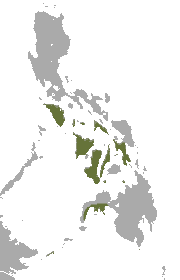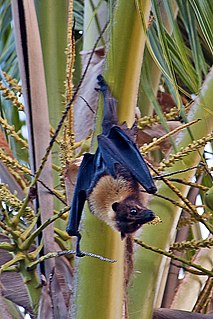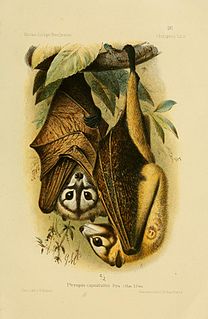
The Aldabra flying fox is a species of megabat in the genus Pteropus. It is endemic to the Aldabra Atoll in the Seychelles, like Chaerephon pusilla, though the latter may be the same species as the little free-tailed bat.

The Ryukyu flying fox or Ryukyu fruit bat is a species of megabat in the family Pteropodidae. It is found in Japan, Taiwan, and the Batanes and Babuyan Islands of the Philippines. Its natural habitats are subtropical or tropical dry forests and subtropical or tropical swamps. It is threatened by habitat loss and by hunting for food and the IUCN classify it as "Vulnerable".

The Nicobar flying fox is a species of flying fox in the family Pteropodidae. It is endemic to India. Its natural habitats are subtropical or tropical moist lowland forest and subtropical or tropical swamps. It is threatened by habitat loss due to forest clearing.

The Ontong Java flying fox is a species of flying fox in the family Pteropodidae. It is endemic to the Ontong Java Atoll in the Solomon Islands. Its natural habitats are subtropical or tropical dry forests and subtropical or tropical swamps. It was classified as "Critically Endangered" in 2021 by the IUCN. Its confirmed range extends only over small islands, all of which are near to sea level. It is threatened by rising sea levels.

The white-winged flying fox, also known as the mottle-winged flying fox is a species of bat in the family Pteropodidae. They are endemic to the Philippines. Their natural habitat is subtropical or tropical dry forests. They are threatened by habitat loss. In 2008, Giannini et al. revived the genus Desmalopex and placed D. leucopterus in it.

The Lombok flying fox is a species of megabat in the genus Pteropus. It is endemic to Indonesia. This species has been listed on Appendix II of CITES since 1990, along with most others in the genus Pteropus. It was classified as "Least Concern" by the IUCN in 1996, but was changed to "Data Deficient" in 2008 due to uncertainty of the abundance and possible threats from hunting and habitat destruction.

The black-eared flying fox, species Pteropus melanotus, is a bat of the family Pteropodidae (megabats). Also known as Blyth's flying fox, it is found on the Andaman Islands and Nicobar Islands (India), and in Sumatra (Indonesia). A population on Christmas Island, which is critically endangered, has been placed as a subspecies of this population. The conservation and taxonomic status of that population was later re-established as a distinct species, the Christmas Island fruit-bat Pteropus natalis.

The Temotu flying fox is a species of flying fox in the family Pteropodidae. It is endemic to the Solomon Islands. It is threatened by habitat destruction due to subsistence agricultural practices, as well as natural disasters such as tropical cyclones. Due to its imperiled status, it is identified by the Alliance for Zero Extinction as a species in danger of imminent extinction. In 2013, Bat Conservation International listed this species as one of the 35 species of its worldwide priority list of conservation.

The Ceram fruit bat or Seram flying fox is a species of megabat in the family Pteropodidae. It is endemic to the mountainous forests of two Maluku islands, Buru and Seram, including the Manusela National Park on Seram. They were once present on the nearby Ambon Island, but probably not anymore. The habitat has an area of less than 20,000 km2, and is decreasing due to logging. For this reason, and because of hunting by the local population, these species are listed as vulnerable by the IUCN since 1996.

The ornate flying fox is a species of flying fox in the family Pteropodidae. It is endemic to New Caledonia. Its natural habitat is subtropical or tropical dry forests. It is threatened due to habitat destruction and hunting, the former exacerbated by high roost-site fidelity.

Pteropus pelagicus is a species of fruit bat in the family Pteropodidae. It includes two subspecies that were formerly recognized as full species— Pteropus insularis and Pteropus phaeocephalus. It is endemic to Micronesia. It is threatened by habitat loss.

The Bonin flying fox, Bonin fruit bat, or in Japanese Ogasawara giant bat is a species of flying fox in the family Pteropodidae. It is endemic to four islands in Ogasawara Islands, Japan. Its natural habitat is subtropical forests. It is threatened by habitat loss.

The little golden-mantled flying fox is a species of bat in the family Pteropodidae. It is found in Indonesia and the Philippines. Its natural habitat is subtropical or tropical dry forests. It is threatened by hunting and habitat loss, as well as pollution.

The Samoa flying fox or Samoan flying fox is a species of flying fox in the family Pteropodidae. It is found in American Samoa, Fiji, and Samoa. Its natural habitat is subtropical or tropical dry forests. It is threatened by habitat loss.

The Philippine gray flying fox is a species of flying fox in the family Pteropodidae. It is found in Indonesia and the Philippines. Its natural habitat is subtropical or tropical dry forests. It is threatened by habitat loss.

The insular flying fox or Pacific flying fox is a species of flying fox in the family Pteropodidae. It is geographically widespread, the most widespread flying fox in the Pacific: it is found in American Samoa, the Cook Islands, Fiji, New Caledonia, Niue, Papua New Guinea, Samoa, the Solomon Islands, Tonga, and Vanuatu.

The Vanikoro flying fox, also known locally as basapine, is a species of bat in the family Pteropodidae. It has only been found in the Vanikoro island group located in the southern Solomon Islands. The species as a whole was originally known from just a few specimens collected sometime before 1930 but following surveys conducted on the island in the early 1990s did not detect this species again causing the Vanikoro flying fox to be listed as extinct. However, the species was rediscovered by a survey conducted in late 2014 which indicated a population in the high hundreds or low thousands and reported all observations.

The Bismarck masked flying fox is a species of flying fox in the family Pteropodidae found in Papua New Guinea and named after the Bismarck Archipelago. It was once considered a subspecies of Pteropus temminckii before being reassessed in 2001. This species has two subspecies, P. c. capistratus and P. c. ennisae. The IUCN classified it as Near Threatened in 2009, noting that the rate of decline is almost high enough to reclassify the species as Vulnerable.

The Kei flying fox is a species of megabat in the genus Pteropus found in the Kai Islands of Indonesia. It was formerly considered a subspecies of the black-bearded flying fox. Very little is known about the species, its habitat, or threats to it.

The Pelew flying fox is a species of megabat in the genus Pteropus found in the Palau Islands. A subspecies found on Yap, the Yap flying fox, is considered as a separate species by some authorities. The species is listed as vulnerable by the IUCN due to commercial and small-scale hunting; commercial hunting for the species was banned in 1994, but local exploitation is commonplace. The species is listed on CITES appendix I.






















